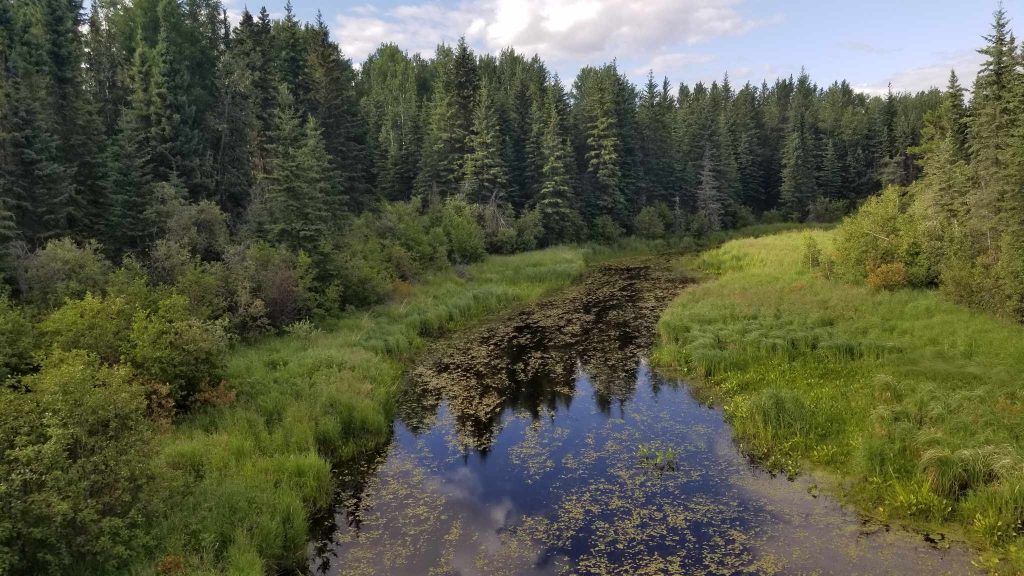
The land south of Hanson Lake in east-central Saskatchewan is filled with muskegs among dense forest, a wild rice patch and home to the at-risk woodland caribou. Some are worried that this traditional territory will soon be destroyed.
Foran Mining Corporation is proposing a project in the area. It would mine and process up to 4,200 tonnes of ore a day from the McIlvena deposit.
The ore would then be transported to Flin Flon, where it would be distributed for smelting. Smelting is the process of extracting precious metals – in this case, copper, zinc, and small amounts of gold and silver.
“Everyone always talks about bringing opportunities to the community. They call it ‘opportunity,’ but that is just short-term jobs, maybe the odd scholarship,” said Miriam Körner, a founding member of For Peat’s Sake – Protecting Northern Saskatchewan Muskegs.
“That land provides already for the people in that area.”
Foran says the McIlvena Bay project abides by Saskatchewan’s growth plan. It will increase the Indigenous footprint in the economy, develop the labour force and increase qualities of life, according to a document on the provincial government’s website.
But to Körner, “you can’t put a dollar amount on the risk” to the environment.

She’s voicing concerns about water contamination, lowering the groundwater table on peatlands, deforestation and greenhouse gas emissions. One of her biggest concerns, though, is the woodland caribou.
Foran said it’s working with the Peter Ballantyne Cree Nation on a caribou mitigation project, which would use trail cameras to track its impact on wildlife.
“You destroy something, and then you mitigate for it. Once the caribou are gone, they’re gone,” said Körner.
“That is what really got our alarm flags up because they are so threatened already.”
Woodland caribou were listed as threatened under Saskatchewan’s At-Risk Species Act in 2003. According to the Government of Canada, boreal caribou populations have declined across the country due to habitat disturbance by humans.
An environmental impact assessment found 35 caribou sightings on the proposed land, with the group size estimated at 27 animals.
In an emailed statement, Foran said it’s also implementing management for tailings – a byproduct of mining from leftover rock and soil – and water recycling.
“Regular environmental monitoring will be conducted of the surface water and the treated water as well as the fish, aquatic biota, and sediments to ensure the environment remains protected,” reads the statement.
Foran also said it won’t be doing “extensive deforestation.” Since it would be an underground mine on a former site, 60 per cent of the area is already developed, according to Foran.
The project would also remove 13 hectares of muskeg, while threatening another 468 hectares through lowering groundwater levels. Foran said this would also be monitored.
The company’s website says copper and zinc are materials needed to “decarbonize the world,” and that climate change is at the forefront of its vision.
“That technology might sound green for somebody who lives in Saskatoon and doesn’t really think about where all those rare metals come from. They’re being taken out of the north. They’re destroying traditional lands that are important to the people,” said Körner.
‘We don’t want any mining, period’
Elder Eileen Linklater was part of a protest last week in Pelican Narrows against the McIlvena Bay Project.
“As First Nations, we like openness. We don’t like to lock up our areas and put up a sign to not trespass,” she said.
“We don’t want any mining, period, because we know what’s going to happen and how it’s going to affect our lands.”
Linklater said the Hanson Lake area is filled with medicines, rice and mushrooms. Indigenous people rely on the area for trapping, she said, and some even sell wild mushrooms to supplement their income.
“It’s going to destroy our way of life – our water, our animals, our medicines, our trees, our air.”

Linklater said community members aren’t being properly consulted about the project. She’s been particularly frustrated with a lack of communication from the Peter Ballantyne Cree Nation, which she said has an obligation to represent its communities.
She said the environmental impact assessment isn’t accessible for many northerners.
“There’s not even a consultation because nobody can say what they want to say,” said Linklater.
“On behalf of the membership who understand what’s going on, we had to explain to our membership in Cree what is going to be happening.”
The province’s Ministry of Environment is accepting public comments on the McIlvena Bay Project until Tuesday. Linklater said many in the north don’t have access to computers or the internet to provide their input.
Norma Bear, who lives in Sandy Bay, said increased traffic around her home community is concerning.
“We pick medicines; we are land users; we host sundances; we have our own baptism, adoption, marriage; we have our own way of life here,” said Bear.
“That’s going to affect us because of all of the traffic that’s going to happen from the mine. It’s going to take our hunting and fishing rights away because we can’t even go into that area anymore.”
Bear added that the development will make it more difficult for community members to travel to Flin Flon for groceries.
The McIlvena Bay Project is proposed on Peter Ballantyne Cree Nation (PBCN) territory.
In an emailed statement, Chief Karen Bird said the PBCN has been working with a team of independent experts since May 2022 in its review of the project. This includes biologists, a chemical engineer, a senior scientist who focuses on human health and a regulatory lawyer.
“(PBCN) has recommended regulatory commitments of approval to both the Saskatchewan government and the company to support PBCN’s goal of avoiding or mitigating potential impacts on both the environment and on PBCN Treaty and Aboriginal rights.”
Linklater started a petition against the project, which community members signed as part of the protest. As of Thursday, she had about 300 signatures.

